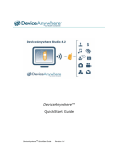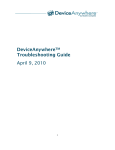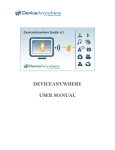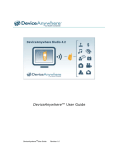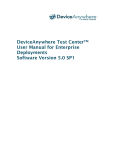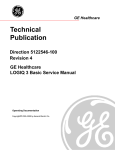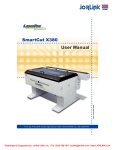Download DeviceAnywhere™ Troubleshooting Guide May 19, 2009
Transcript
DeviceAnywhere™ Troubleshooting Guide May 19, 2009 DeviceAnywhereTM QuickStart Guide Revision 1.5 ©2009 Mobile Complete, Inc. All rights reserved. THE INFORMATION CONTAINED IN THIS DOCUMENT IS PROVIDED “AS IS” WITHOUT ANY EXPRESS REPRESENTATIONS OF WARRANTIES. IN ADDITION, MOBILE COMPLETE, INC., DISCLAIMS ALL IMPLIED REPRESENTATIONS AND WARRANTIES, INCLUDING ANY WARRANTY OF MERCHANTABILITY, FITNESS FOR A PARTICULAR PURPOSE, OR NON-INFRINGEMENT OF THIRD PARTY INTELLECTURAL PROPERTY RIGHTS. DeviceAnywhere Troubleshooting Guide Version 1.4 All text and figures included in this publication are the exclusive property of Mobile Complete Inc., and may not be copied, reproduced, or used in any way without the express permission in writing of Mobile Complete Inc. Information in this document is subject to change without notice and does not represent a commitment on the part of Mobile Complete, Inc. Mobile Complete, Inc may have patents or pending patent applications covering subject matter in this document. The furnishing of this document does not give you any license to these patents except as expressly provided in any written license agreement from Mobile Complete, Inc. Mobile Complete, the Mobile Complete logo, DeviceAnywhere, DeviceAnywhere Studio, DeviceAnywhere Pro, DeviceAnywhere Monitoring, DeviceAnywhere Consumer, and MyDeviceAnywhere are trademarks of Mobile Complete, Inc. in the United States and/or other countries. This document also contains registered trademarks, trademarks and service marks that are owned by their respective owners. Mobile Complete, Inc. disclaims any responsibility for specifying marks that are owned by their respective companies or organizations. If you have any comments or suggestions regarding this document, please send them by e-mail to [email protected]. Mobile Complete, Inc. 1730 South Amphlett Blvd., STE. 300 San Mateo, CA 94402 USA DeviceAnywhereTM QuickStart Guide Table of Contents 1 DeviceAnywhere Studio doesn’t install and/or launch........4 2 DeviceAnywhere Studio Installation or Launch is Slow ......5 3 Downloading an application (non-BREW) to a DeviceAnywhere handset fails. .........................................5 3.1 3.2 3.3 3.4 Sprint .......................................................................... Sprint/Nextel ................................................................ Helio ........................................................................... All Other Carriers .......................................................... 6 7 7 8 4 Uploading a BREW application to a DeviceAnywhere handset fails. .................................................................8 5 The device is unable to receive calls or text messages. .....9 6 The device can’t access a URL. ......................................9 7 The device response is slow. .........................................10 8 Streaming videos won’t play. ........................................10 9 The device appears frozen. ...........................................11 10 The device screen is distorted......................................12 11 When text is executed on the device, the wrong characters appear on the screen.......................................13 12 Audio fails to play. .....................................................13 13 No reply is received from Issues reported to DeviceAnywhere Support.................................................14 Revision 1.5 DeviceAnywhere Confidential Table of Contents 3 DeviceAnywhereTMTroubleshooting Guide DeviceAnywhere Troubleshooting Guide The DeviceAnywhere™ Troubleshooting Guide describes problems that you may encounter while using DeviceAnywhere Studio and provides detailed troubleshooting procedures for resolving them. Each problem is separated into possible scenarios that may occur. This guide covers the most commonly experienced issues. If the specific issue or scenario you are experiencing is not included, contact [email protected] for assistance. 1 DeviceAnywhere Studio doesn’t install and/or launch. Scenario: The system hangs and doesn’t accept keyboard input. You will receive a prompt that says “Unable to connect to DeviceAnywhere. Try to restart DeviceAnywhere in a few minutes. If error persists, contact support.” When your system hangs during installation or launch, it means your system was unable to connect to the DeviceAnywhere server on port 443. This port is used for communication between the Access server and DeviceAnywhere Studio client. A. Make sure your network connection is in operation. B. Make sure the deviceanywhere.com website is white-listed in firewall or proxy server settings to open the firewall. This usually includes opening port 443 for all traffic, and possibly whitelisting the deviceanywhere.com domain. Note: There is a known incompatibility with Bluecoat proxy servers. In order to use DeviceAnywhere, your IT team needs to go into the Policy File and edit the local file with the text editor. Your IT team should enter the following statement under the <Proxy> section header: url.domain=deviceanywhere.com detect_protocol(none). Contact [email protected] for further information on resolving this issue. 4 DeviceAnywhere Troubleshooting Guide DeviceAnywhere Confidential Revision 1.5 DeviceAnywhereTMTroubleshooting Guide 2 DeviceAnywhere Studio Installation or Launch is Slow Scenario: DeviceAnywhere Studio installation or launch takes more than ten minutes to complete. A. Make sure that your computer adheres to the preferred system requirements given in Section 1.2 of the DeviceAnywhere QuickStart Guide. DeviceAnywhere System Requirements: • 2 GHz Pentium 4 dual core processor • 1024 MB RAM (1GB RAM), 2GB recommended • 10 GB Hard Disk Drive available • Broadband Internet connection When DeviceAnywhere is running on a computer with insufficient memory or other applications running on the computer concurrently are using a lot of memory, the computer can swap out memory to disk. This action greatly slows down DeviceAnywhere response time. We recommend at least 1 GB of memory in the computer, and have seen increased performance with 2 GB of memory. Installation time is affected by your internet connection. As indicated in the system requirements, a high bandwidth connection is recommended. B. Some anti-virus software have port filtering settings turned on for port 443 by default. Since all data communication occurs on port 443 between the DeviceAnywhere client installed on your computer and our DeviceAnywhere servers, the DeviceAnywhere response time is delayed. Remove port filtering on port 443 to correct the problem. Note: Kaspersky Anti-virus software has port filtering turned on for port 443 by default. C. If your connection has a trace route of multiple hops (greater than ten) and the latency for each of these hops is large, you can experience degradation due to Internet latency. If you experience significant installation latency, contact us at [email protected] so that we can help you resolve this issue. 3 Downloading an application (non-BREW) to a DeviceAnywhere handset fails. Scenario: Over-the-air installation of applications for Blackberry, Palm, Symbian, and Microsoft platforms, and any other non-BREW platform fails. Applications don’t download to the device. General information A. MIME Types When you are having trouble downloading over-the-air from your own server, check your MIME types. Revision 1.5 DeviceAnywhere Confidential DeviceAnywhere Studio Installation or Launch is 5 DeviceAnywhereTMTroubleshooting Guide B. Signing Policies Mobile carriers have very strict signing policies, and many applications will not load or work unless they are properly signed with the correct certificates. DeviceAnywhere Technical Managers cannot offer support with certificate signing. You need to contact the carrier for more information. C. Carrier Application-Specific Servers Many carriers support application-specific servers to download applications to their devices. Try uploading your application to the carrier application-specific server, and download the application based on the carrier’s standard procedure. D. Device issues error “certificate expired” when I access my .Jad file. First, check that your certificate is valid. Then, check the date on the device. Sometimes when a device is restored to factory default settings, the date is rolled back to the manufacturing date. In this case, reset the date on the device to the current date. Your certificate should be authenticated as valid. Carrier Specific Information 3.1 Sprint Sprint supports a website and software tool, Total Uploader, to upload applications to Sprint devices. This site is used for CDMA phones. To Upload with the Sprint Total Uploader: 1. In DeviceAnywhere Studio, access and Acquire the device you want to upload to. 2. Go to the Sprint total uploader website- http://ra.pcslab.com/upload/index.php. 3. 4. 5. 6. Upload the application and type in the phone number of the Sprint VDL device you want to download your application to. Click submit. When the device in the VDL gets the SMS notification of new file to download, navigate to the message and open it. Scroll down the message and click on the link in the SMS to initiate the download. Scenario: A message pops up indicating a 909 error while downloading to a Sprint device. When you receive a 909 error when trying to download an application, the particular Sprint device you are downloading to is not "Root Enabled." Note: Sprint devices are "Developer Root Enabled" or "Root Certificate Enabled" which means they have been put into a mode where the applications you load onto the devices have access to the restricted APIs on the device. This basically means the applications do not need to be signed by anything other than the standard certification available on the Sprint developer portal. 6 Downloading an application (non-BREW) to a DeviceAnywhere Confidential Revision 1.5 DeviceAnywhereTMTroubleshooting Guide Report this error by sending an email to [email protected] or click on the Report an Issue icon in DeviceAnywhere Studio. DeviceAnywhere Support will contact Sprint to have the root enabled. Scenario: The ESN for the Sprint Device is missing. All Sprint devices are root enabled and set to Development mode. If you require an ESN for a Sprint device, send the request to [email protected] For more information, the following URL provides a detailed description of Sprint errors: http:// www.sprintusers.com/forum/archive/index.php/t-38328.html 3.2 Sprint/Nextel Sprint supports a website to upload applications to Nextel devices. This website is the Mobile Application Manager (MAM). This site supports iDEN devices. To Upload with the MAM: 1. In DeviceAnywhere Studio, click Menu to open the device menu. 2. Navigate to the URL entry field on the device. 3. Enter https://mam.cellmania.com/mam/login.do. 4. Click Login. 5. Log on to the site by entering the User ID: MobileComplete (case sensitive) 6. Enter the Password: 2006Blue (case sensitive) 7. Navigate down to the Application Library. 8. 9. 3.3 Select Upload Application to upload the .Jad and .Jar files of the applications on to MAM. The application will then populate the Application Library. Assign the application to the phones by clicking on Assign to Phones. Make sure to select your target device. The application will then download to the device. Helio To upload applications on Helio devices. 1. Go to http://www.myhelioapps.com. 2. Log in with your user name and password. 3. After the login process, click Submit Media. You will be prompted to upload the JAVA application, ringtones and wallpapers. 4. Browse to the JAR file you want to install on the Helio device. 5. Press Upload Media Button. 6. 7. 8. 9. 10. Revision 1.5 On the next page, enter the correct information in the Send to phone (Helio only) field. Enter the phone number and press Send button. The handset will then receive a SMS containing a URL. Navigate to the URL. You will be redirected to a page with a Download link. Click Page Adapted for Mobile Device. View in HTML. You need to view this page in HTML before downloading the application to install the application. Click the Download Now! option. The application is downloaded and installed on the Helio handset. DeviceAnywhere Confidential Downloading an application (non-BREW) to a 7 DeviceAnywhereTMTroubleshooting Guide 3.4 All Other Carriers All other carriers do not have a special way of loading applications to devices. You must load the .Jad and .Jar files onto a file server, and then using the browser on the device, enter the URL of the .Jad file. This action downloads and installs the .Jad and .Jar files. 4 Uploading a BREW application to a DeviceAnywhere handset fails. Scenario: Applications don’t upload to a BREW device. Applications for BREW devices can only be uploaded through a data cable. DeviceAnywhere has created an integration with BREW within DeviceAnywhere Studio to upload applications. To upload a BREW application to a device, do the following: 1. In DeviceAnywhere Studio, right click on the device. The Device menu is displayed. 2. Select Hardware Control. 3. Select Connect Data Cable. This action initiates the data cable of the device. 4. Right click on the device. The Device menu is displayed. 5. Select BREW. 6. Select Upload Application. The Upload BREW application dialog box appears. 7. Enter the name of the application to be uploaded (case-sensitive). 8. Select the local directory for all the application files when prompted. 9. 10. 11. When the Uploading BREW application screen shows the BREW file has uploaded successfully, click close to dismiss the screen. Now hold the power button for 5-10 seconds until the phone powers off. Then wait 5 seconds and power on the device by holding down the power button for 5-10 seconds. Note: Ensure that the name of your application corresponds to your .mif file. Scenario: A message pops up with the error message: “SIG file error: Unable to load applications.” To test a BREW application you must generate your own signature file and supply the ESN or MEID of the device in hexadecimal format. Signature (SIG) files are device-specific files that are required for each device you are using for your application development. These files must be obtained from Qualcomm and are good for 90 days. After 90 days, the signature file expires, and Qualcomm must issue a new signature file. Only one SIG file is required per device. However, because each individual application requires its own corresponding SIG file, you must make a copy of the original SIG file and rename it to match the name of the application you have created. Remember that the SIG file must reside in the same folder as the MIF file, the application file for the BREW device. You must be an authenticated BREW developer to access the signature generation utility on the BREW website. See the Qualcomm website at http://brew.qualcomm.com/brew/en/ for more information. 8 Uploading a BREW application to a DeviceAnywhere DeviceAnywhere Confidential Revision 1.5 DeviceAnywhereTMTroubleshooting Guide To obtain a SIG file, follow these steps: 1. 2. Select BREW Testing Generator. 3. Enter your BREW developer user name and password. 4. 5. 6. 5 Go to the BREW website and navigate to the page that contains the link to the web-based test signature generator. In the ESN field, type the ESN number that is located in the Properties screen of the device. (Double click on a device to display the Properties screen.) Click Generate and wait for the Download Signature link to appear. Download the signature and save the file; it will be required for all testing on the device. The device is unable to receive calls or text messages. Scenario: Calls and text messages are lost in the network. The device never rings or receives an alert message. A. Check the phone settings and make sure call forwarding is turned off. Dial *720 and then press SEND. This action turns call forwarding off if it has been set. B. The phone number you are using for testing is not the correct phone number for the device. Look up the actual phone number: 1. 2. 3. Select Menu. Select phone settings (profiles or a similar menu item) to display the phone number of the device. Make sure the phone number you are using is the same as the one listed on the phone. When the number in the Properties screen is inconsistent with the phone number shown in phone settings on the device, please report the problem to [email protected]. If you are still unable to receive calls or text messages on a device, report the problem to [email protected]. 6 The device can’t access a URL. Scenario: After launching the WAP browser and entering the URL, the website does not appear. A. Validate web access by navigating to a popular website such as Google or YouTube. If the screen remains blank, report the problem to [email protected]. B. Check the signal strength indicator. Signal strength at 2 bars or less can cause the transmission to fail. Report the problem to [email protected]. C. The website may not be operating or may not support WAP browsing. You can validate website operation through your computer browser. Revision 1.5 DeviceAnywhere Confidential The device is unable to receive calls or text mes- 9 DeviceAnywhereTMTroubleshooting Guide 7 The device response is slow. Scenario: After acquiring one or more devices, the response time for command execution on a device in DeviceAnywhere becomes very slow. A. Make sure that your computer adheres to the preferred system requirements given in Section 1.2 of the DeviceAnywhere QuickStart Guide. When DeviceAnywhere is running on a computer with insufficient memory or other applications running on the computer concurrently are using a lot of memory, the computer can swap out memory to disk. This action greatly slows down DeviceAnywhere response time. We recommend at least 1 GB of memory in the computer, and have seen increased performance with 2 GB of memory. Device response time is affected by your internet connection. As indicated in the system requirements, a high bandwidth connection is recommended. B. Some anti-virus software have port filtering settings turned on for port 443 by default. Since all data communication occurs on port 443 between the DeviceAnywhere client installed on your computer and our DeviceAnywhere servers, the DeviceAnywhere response time is delayed. Remove port filtering on port 443 to correct the problem. Note: Kaspersky Anti-virus software has port filtering turned on for port 443 by default. C. If your connection has a trace route of multiple hops (greater than ten) and the latency for each of these hops is large, you can experience degradation due to Internet latency. If you experience significant installation latency, contact us at [email protected] that we can help you resolve this issue. 8 Streaming videos won’t play. This error appears when the Video Player (Real Player on most handsets) has incorrect or no settings. It is also possible the device does not support streaming video. To resolve the issue, go to the media player settings and select the correct internet profile to play live streaming videos. You can also find this information and check if the handset supports streaming video by searching on the carrier’s support site. 10 The device response is slow. DeviceAnywhere Confidential Revision 1.5 DeviceAnywhereTMTroubleshooting Guide 9 The device appears frozen. Scenario: A newly acquired device is frozen, or after testing and working on the device for a while, the device freezes. A. Unlock the device for keyboard input Many smartphones and touchscreen devices have automatic key locking to lock up device input when the device is not in use. As a result, a device may appear frozen when in fact the keyboard lock is on. Refer to Table 1-1 for the key sequence to unlock various devices. For other devices not listed, refer to the device’s User Manual. Table 1-1 Device Unlock Sequence Device Unlock Key Sequence BlackBerry models Press * and then [Send] BlackBerry 9000 (Bold) [Power/End] HTC G1 Press [Select] [Menu] HTC Diamond [Power] HTC 8925 (Tilt) Touch Unlock iPhone 3G [Power] INQ INQ1 [SoftL] [Select] Nokia 6600 (Slide) Press [Select] * Palm models Press [Power] and the middle navigation key. Palm Treo 850 [Select] Sagem My519X [SoftL] Samsung Instinct Hold the Shift key on your keyboard and press the [Power] button on the device. Samsung SGH T119 [SoftL] [SoftL] Sanyo SPC 2700 [Space] [Back] Sony Ericsson X1 (XPERIA) [Power/End] Sony Ericsson C702 [SoftR] Revision 1.5 DeviceAnywhere Confidential The device appears frozen. 11 DeviceAnywhereTMTroubleshooting Guide B. Device has entered “sleep” mode Many handsets go into a "sleep" mode after extended periods of no use (the screen will be blank). If you acquire a DeviceAnywhere handset, and the device's screen is blank, pressing either the POWER key or the END key will typically wake up the device. If the device is a smartphone or touchscreen device, you must further unlock the keyboard for input by pressing the appropriate key sequence for the device, as described above. C. Wake up the device with hardware reset Hardware reset is used as a last resort to wake up a device, since it takes more time to initialize the device than other techniques. If the previous techniques don’t wake up the device, try hardware reset to clear the device: • Power cycle the device by pressing and holding the END key. Then turn the device back on. • Disconnect the battery. 1. Right click the device. The Device menu appears. 2. Select Hardware Control. 3. Select Disconnect Battery. 4. Select Connect Battery. 5. Press and hold the END key to turn the device back on. If the device remains frozen, report the problem to [email protected]. 10 The device screen is distorted. Scenario: The screen shows flicker, static, or screen shift. Try hardware reset techniques to clear the device: • Power cycle the device by pressing and holding the END key. Then turn the device back on. • Disconnect the battery. 1. Right click the device. The Device menu appears. 2. Select Hardware Control. 3. Select Disconnect Battery. 4. Select Connect Battery. 5. Press and hold the END key to turn the device back on. If screen distortion persists, report the problem to [email protected]. 12 The device screen is distorted. DeviceAnywhere Confidential Revision 1.5 DeviceAnywhereTMTroubleshooting Guide 11 When text is executed on the device, the wrong characters appear on the screen. Scenario: The text on the screen doesn’t match the typed text. A. Mobile devices support different key modes. Each entry field in a device is typed to a particular key mode. For example, the entry field for a telephone number used in sending a text message can only receive numeric input. When entering text into entry fields, make sure to use the correct key mode. Key modes include Alpha, Numeric, and Web URL. When entering data into an entry field on a device through the Copy & Paste command, you must explicitly select the key mode from the drop-down menu. What happens when you don’t use the correct key mode? When you paste a telephone number using the text key mode, the number appears garbled on the device screen and expands to a list of useless numbers. In the example below, the original telephone number is expanded to 30 digits. Original telephone number: 1-318-262-9022 Pasted telephone number with wrong key mode: 1111 33-331-1118888-22-226-6662222 In text mode on most standard T9 devices, a key must be pressed four times to cycle through the letters and arrive at the desired number. As a result, in this example each number is typed four times when in text mode instead of numeric mode. B. The typing speed of text entered through the keyboard can also effect the text displayed on the screen. DeviceAnywhere has a hold down key setting of 300 milliseconds. If you enter two keystrokes within the 300 milliseconds window, the first key is dropped or incorrectly recorded. Slow down your typing speed to allow the device to correctly record each key. C. Mobile devices have a setting for predictive text. This feature is also known as T9, Smartext, Primary input, or Abc text. When text errors or double letters appear on the screen, predictive text may be effecting your input. In this case, navigate to the Text Input settings and either set your device to regular Abc text or turn off predictive text. D. DeviceAnywhere handsets use hardware key mapping to enable live interaction with a device over the Internet. On occasion the key mapping is incorrect. If you use the three techniques above and the text input still does not display correctly, then report the problem to [email protected] 12 Audio fails to play. Scenario: When music or a multimedia file is played on the device, no sounds come out of the computer speaker. A. Verify the operating system is Windows XP. There are known incompatibilities in playing audio with other operating systems. B. Make sure all settings that enable audio in DeviceAnywhere Studio are turned on. • Enable Audio • Turn on the Speaker • Set the sound volume to a higher setting Revision 1.5 DeviceAnywhere Confidential When text is executed on the device, the wrong 13 DeviceAnywhereTMTroubleshooting Guide C. Make sure to turn on your computer speaker and adjust the volume. Validate audio on your computer by listening to music or a video on a media player. 13 No reply is received from Issues reported to DeviceAnywhere Support. DeviceAnywhere Support immediately acknowledges all reported issues via automated email response and typically follows up with issue status, resolution, or clarification within 4 hours. If you do not receive an email response from Support: A. The emails from DeviceAnywhere Support may be going to your junk mail. Please make sure DASupport@deviceanywherecom is on your safe list. B. Support responses are sent to the email corresponding to the username of your DA account. When you report an issue and your DeviceAnywhere username is not your usual email address, be sure to include the correct email address where you want the response to be sent in the comments section of the Report an Issue form. 14 No reply is received from Issues reported to DeviceAnywhere Confidential Revision 1.5














